The Impact of Peer Pressure on Academic Performance at BulSU
VerifiedAdded on 2022/10/12
|6
|1425
|27
Report
AI Summary
This document is a thesis proposal defense report from the Psychology Department at Bulacan State University, focusing on the impact of peer pressure on the academic performance of college students. The study employs a non-experimental quantitative design using questionnaires to measure peer pressure and academic performance. The research includes a review of existing literature, methodology involving random sampling of 100 students aged 19 and above, and the use of established questionnaires adapted from previous studies. The study aims to determine the perceptions of students regarding peer groups, peer influence, and academic performance, with the intention of identifying the positive impact of peer pressure. Data will be analyzed using SPSS 18.0, employing inferential statistics and correlation analysis to determine the relationship between variables. The study adheres to ethical considerations, including informed consent and data confidentiality, and it was accepted with minor revisions following the oral examination.
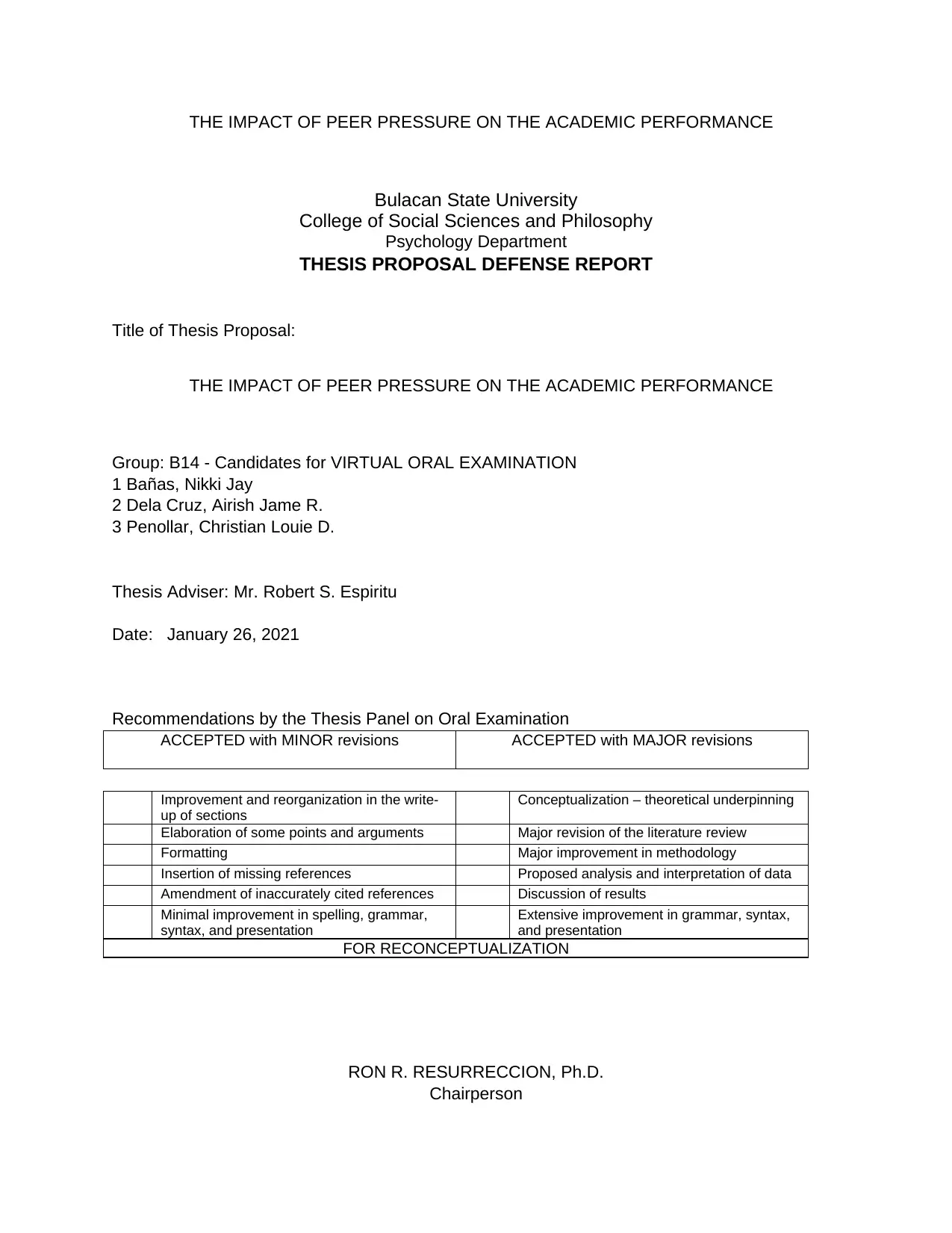
THE IMPACT OF PEER PRESSURE ON THE ACADEMIC PERFORMANCE
Bulacan State University
College of Social Sciences and Philosophy
Psychology Department
THESIS PROPOSAL DEFENSE REPORT
Title of Thesis Proposal:
THE IMPACT OF PEER PRESSURE ON THE ACADEMIC PERFORMANCE
Group: B14 - Candidates for VIRTUAL ORAL EXAMINATION
1 Bañas, Nikki Jay
2 Dela Cruz, Airish Jame R.
3 Penollar, Christian Louie D.
Thesis Adviser: Mr. Robert S. Espiritu
Date: January 26, 2021
Recommendations by the Thesis Panel on Oral Examination
ACCEPTED with MINOR revisions ACCEPTED with MAJOR revisions
Improvement and reorganization in the write-
up of sections
Conceptualization – theoretical underpinning
Elaboration of some points and arguments Major revision of the literature review
Formatting Major improvement in methodology
Insertion of missing references Proposed analysis and interpretation of data
Amendment of inaccurately cited references Discussion of results
Minimal improvement in spelling, grammar,
syntax, and presentation
Extensive improvement in grammar, syntax,
and presentation
FOR RECONCEPTUALIZATION
RON R. RESURRECCION, Ph.D.
Chairperson
Bulacan State University
College of Social Sciences and Philosophy
Psychology Department
THESIS PROPOSAL DEFENSE REPORT
Title of Thesis Proposal:
THE IMPACT OF PEER PRESSURE ON THE ACADEMIC PERFORMANCE
Group: B14 - Candidates for VIRTUAL ORAL EXAMINATION
1 Bañas, Nikki Jay
2 Dela Cruz, Airish Jame R.
3 Penollar, Christian Louie D.
Thesis Adviser: Mr. Robert S. Espiritu
Date: January 26, 2021
Recommendations by the Thesis Panel on Oral Examination
ACCEPTED with MINOR revisions ACCEPTED with MAJOR revisions
Improvement and reorganization in the write-
up of sections
Conceptualization – theoretical underpinning
Elaboration of some points and arguments Major revision of the literature review
Formatting Major improvement in methodology
Insertion of missing references Proposed analysis and interpretation of data
Amendment of inaccurately cited references Discussion of results
Minimal improvement in spelling, grammar,
syntax, and presentation
Extensive improvement in grammar, syntax,
and presentation
FOR RECONCEPTUALIZATION
RON R. RESURRECCION, Ph.D.
Chairperson
Paraphrase This Document
Need a fresh take? Get an instant paraphrase of this document with our AI Paraphraser
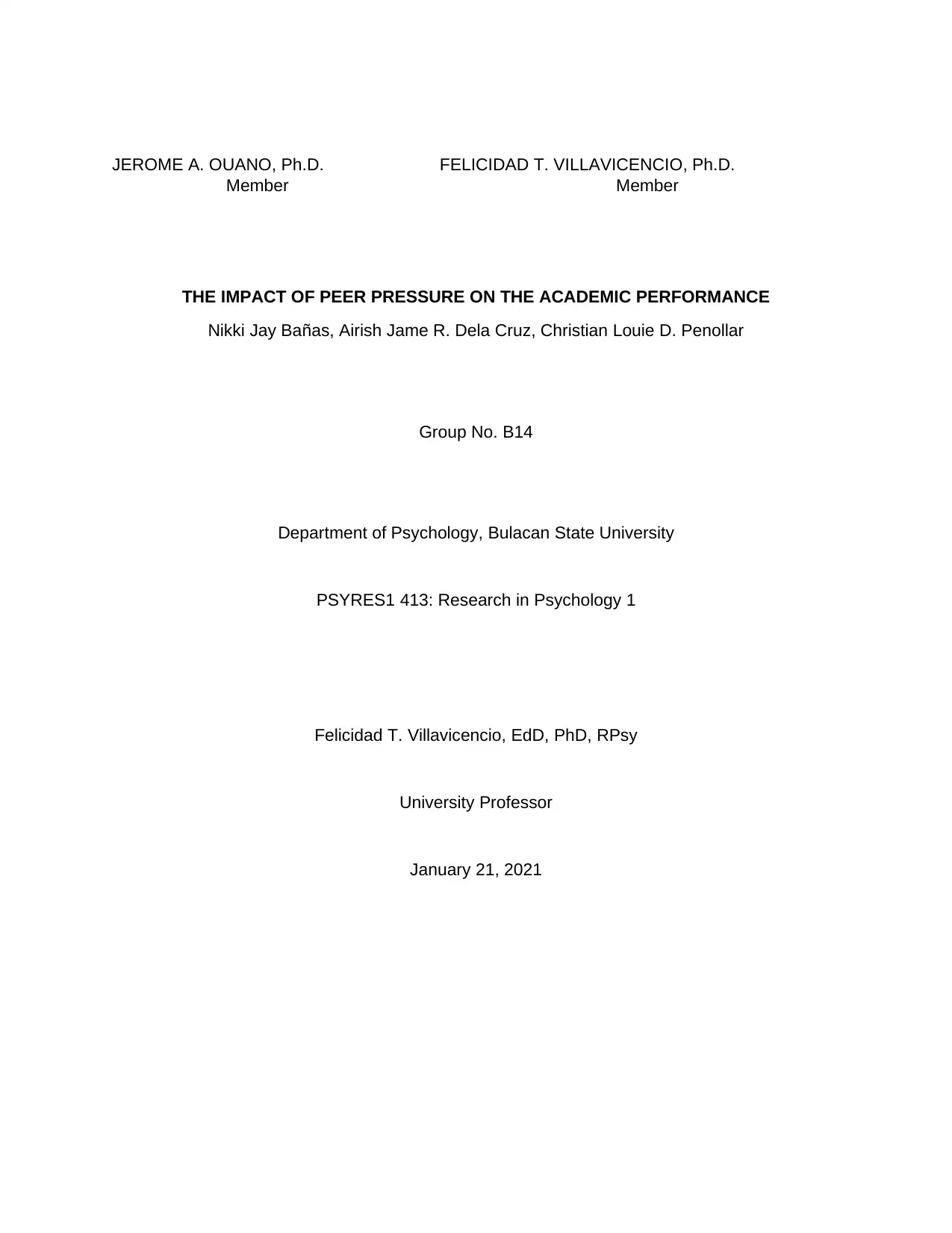
JEROME A. OUANO, Ph.D. FELICIDAD T. VILLAVICENCIO, Ph.D.
Member Member
THE IMPACT OF PEER PRESSURE ON THE ACADEMIC PERFORMANCE
Nikki Jay Bañas, Airish Jame R. Dela Cruz, Christian Louie D. Penollar
Group No. B14
Department of Psychology, Bulacan State University
PSYRES1 413: Research in Psychology 1
Felicidad T. Villavicencio, EdD, PhD, RPsy
University Professor
January 21, 2021
Member Member
THE IMPACT OF PEER PRESSURE ON THE ACADEMIC PERFORMANCE
Nikki Jay Bañas, Airish Jame R. Dela Cruz, Christian Louie D. Penollar
Group No. B14
Department of Psychology, Bulacan State University
PSYRES1 413: Research in Psychology 1
Felicidad T. Villavicencio, EdD, PhD, RPsy
University Professor
January 21, 2021
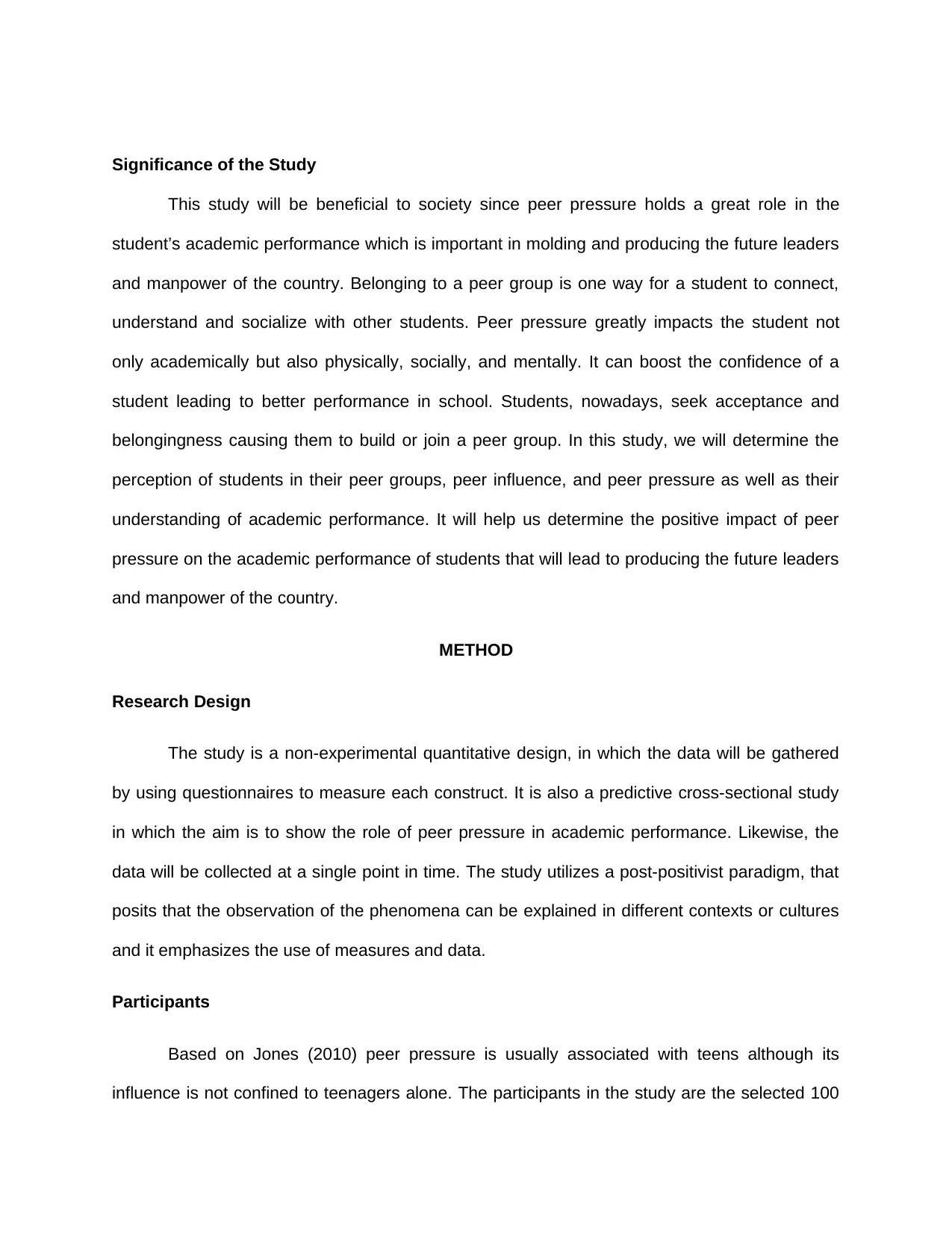
Significance of the Study
This study will be beneficial to society since peer pressure holds a great role in the
student’s academic performance which is important in molding and producing the future leaders
and manpower of the country. Belonging to a peer group is one way for a student to connect,
understand and socialize with other students. Peer pressure greatly impacts the student not
only academically but also physically, socially, and mentally. It can boost the confidence of a
student leading to better performance in school. Students, nowadays, seek acceptance and
belongingness causing them to build or join a peer group. In this study, we will determine the
perception of students in their peer groups, peer influence, and peer pressure as well as their
understanding of academic performance. It will help us determine the positive impact of peer
pressure on the academic performance of students that will lead to producing the future leaders
and manpower of the country.
METHOD
Research Design
The study is a non-experimental quantitative design, in which the data will be gathered
by using questionnaires to measure each construct. It is also a predictive cross-sectional study
in which the aim is to show the role of peer pressure in academic performance. Likewise, the
data will be collected at a single point in time. The study utilizes a post-positivist paradigm, that
posits that the observation of the phenomena can be explained in different contexts or cultures
and it emphasizes the use of measures and data.
Participants
Based on Jones (2010) peer pressure is usually associated with teens although its
influence is not confined to teenagers alone. The participants in the study are the selected 100
This study will be beneficial to society since peer pressure holds a great role in the
student’s academic performance which is important in molding and producing the future leaders
and manpower of the country. Belonging to a peer group is one way for a student to connect,
understand and socialize with other students. Peer pressure greatly impacts the student not
only academically but also physically, socially, and mentally. It can boost the confidence of a
student leading to better performance in school. Students, nowadays, seek acceptance and
belongingness causing them to build or join a peer group. In this study, we will determine the
perception of students in their peer groups, peer influence, and peer pressure as well as their
understanding of academic performance. It will help us determine the positive impact of peer
pressure on the academic performance of students that will lead to producing the future leaders
and manpower of the country.
METHOD
Research Design
The study is a non-experimental quantitative design, in which the data will be gathered
by using questionnaires to measure each construct. It is also a predictive cross-sectional study
in which the aim is to show the role of peer pressure in academic performance. Likewise, the
data will be collected at a single point in time. The study utilizes a post-positivist paradigm, that
posits that the observation of the phenomena can be explained in different contexts or cultures
and it emphasizes the use of measures and data.
Participants
Based on Jones (2010) peer pressure is usually associated with teens although its
influence is not confined to teenagers alone. The participants in the study are the selected 100
⊘ This is a preview!⊘
Do you want full access?
Subscribe today to unlock all pages.

Trusted by 1+ million students worldwide
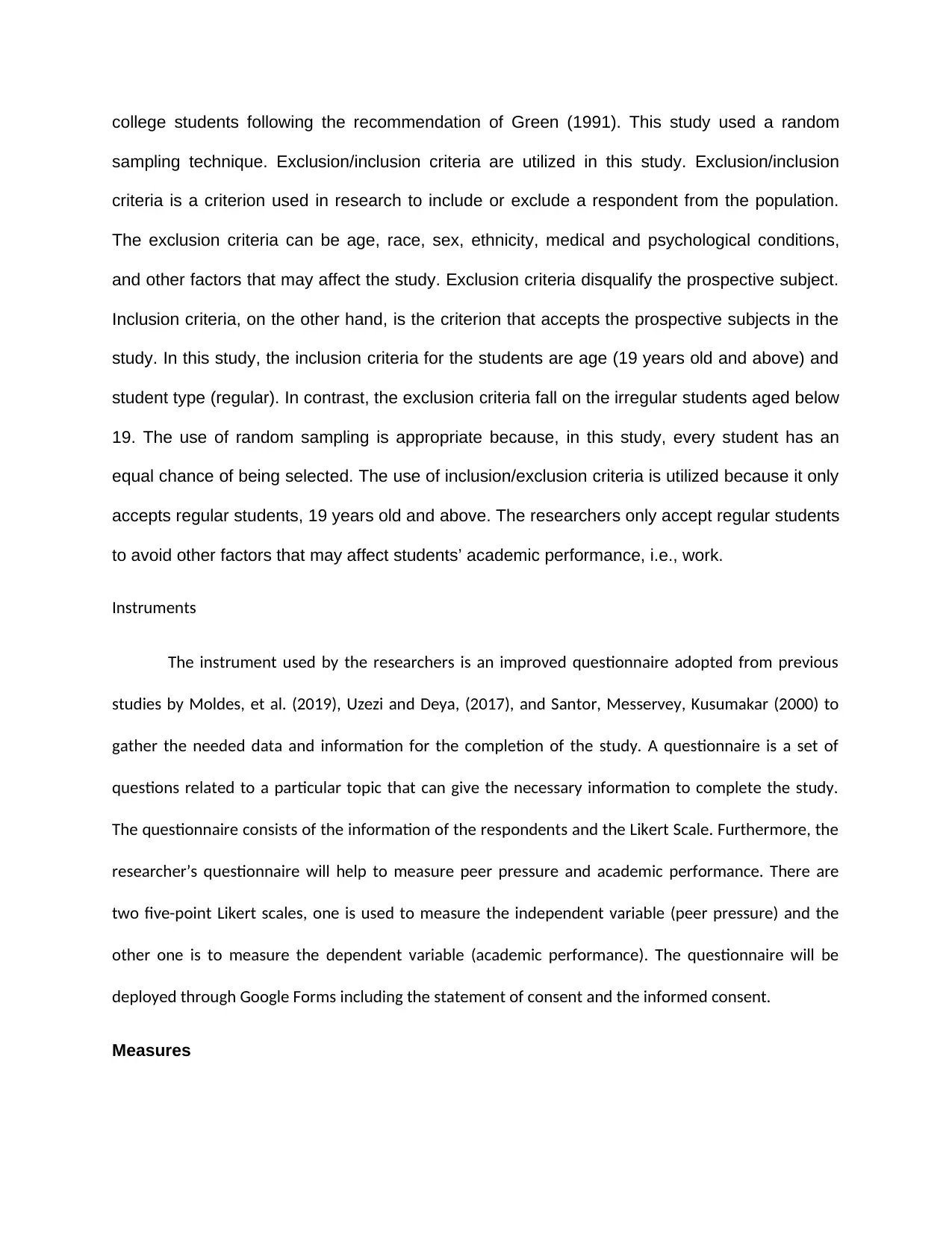
college students following the recommendation of Green (1991). This study used a random
sampling technique. Exclusion/inclusion criteria are utilized in this study. Exclusion/inclusion
criteria is a criterion used in research to include or exclude a respondent from the population.
The exclusion criteria can be age, race, sex, ethnicity, medical and psychological conditions,
and other factors that may affect the study. Exclusion criteria disqualify the prospective subject.
Inclusion criteria, on the other hand, is the criterion that accepts the prospective subjects in the
study. In this study, the inclusion criteria for the students are age (19 years old and above) and
student type (regular). In contrast, the exclusion criteria fall on the irregular students aged below
19. The use of random sampling is appropriate because, in this study, every student has an
equal chance of being selected. The use of inclusion/exclusion criteria is utilized because it only
accepts regular students, 19 years old and above. The researchers only accept regular students
to avoid other factors that may affect students’ academic performance, i.e., work.
Instruments
The instrument used by the researchers is an improved questionnaire adopted from previous
studies by Moldes, et al. (2019), Uzezi and Deya, (2017), and Santor, Messervey, Kusumakar (2000) to
gather the needed data and information for the completion of the study. A questionnaire is a set of
questions related to a particular topic that can give the necessary information to complete the study.
The questionnaire consists of the information of the respondents and the Likert Scale. Furthermore, the
researcher’s questionnaire will help to measure peer pressure and academic performance. There are
two five-point Likert scales, one is used to measure the independent variable (peer pressure) and the
other one is to measure the dependent variable (academic performance). The questionnaire will be
deployed through Google Forms including the statement of consent and the informed consent.
Measures
sampling technique. Exclusion/inclusion criteria are utilized in this study. Exclusion/inclusion
criteria is a criterion used in research to include or exclude a respondent from the population.
The exclusion criteria can be age, race, sex, ethnicity, medical and psychological conditions,
and other factors that may affect the study. Exclusion criteria disqualify the prospective subject.
Inclusion criteria, on the other hand, is the criterion that accepts the prospective subjects in the
study. In this study, the inclusion criteria for the students are age (19 years old and above) and
student type (regular). In contrast, the exclusion criteria fall on the irregular students aged below
19. The use of random sampling is appropriate because, in this study, every student has an
equal chance of being selected. The use of inclusion/exclusion criteria is utilized because it only
accepts regular students, 19 years old and above. The researchers only accept regular students
to avoid other factors that may affect students’ academic performance, i.e., work.
Instruments
The instrument used by the researchers is an improved questionnaire adopted from previous
studies by Moldes, et al. (2019), Uzezi and Deya, (2017), and Santor, Messervey, Kusumakar (2000) to
gather the needed data and information for the completion of the study. A questionnaire is a set of
questions related to a particular topic that can give the necessary information to complete the study.
The questionnaire consists of the information of the respondents and the Likert Scale. Furthermore, the
researcher’s questionnaire will help to measure peer pressure and academic performance. There are
two five-point Likert scales, one is used to measure the independent variable (peer pressure) and the
other one is to measure the dependent variable (academic performance). The questionnaire will be
deployed through Google Forms including the statement of consent and the informed consent.
Measures
Paraphrase This Document
Need a fresh take? Get an instant paraphrase of this document with our AI Paraphraser
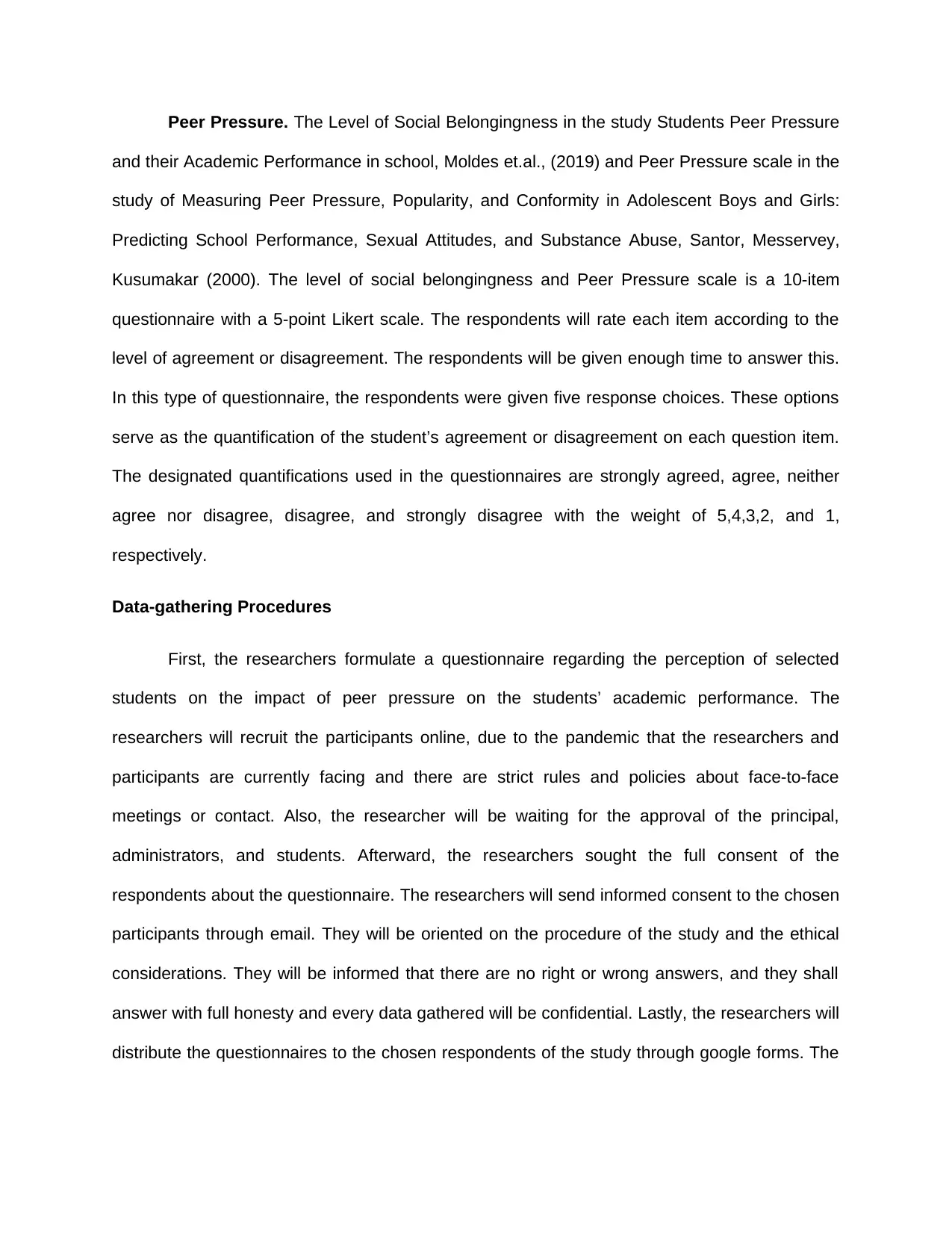
Peer Pressure. The Level of Social Belongingness in the study Students Peer Pressure
and their Academic Performance in school, Moldes et.al., (2019) and Peer Pressure scale in the
study of Measuring Peer Pressure, Popularity, and Conformity in Adolescent Boys and Girls:
Predicting School Performance, Sexual Attitudes, and Substance Abuse, Santor, Messervey,
Kusumakar (2000). The level of social belongingness and Peer Pressure scale is a 10-item
questionnaire with a 5-point Likert scale. The respondents will rate each item according to the
level of agreement or disagreement. The respondents will be given enough time to answer this.
In this type of questionnaire, the respondents were given five response choices. These options
serve as the quantification of the student’s agreement or disagreement on each question item.
The designated quantifications used in the questionnaires are strongly agreed, agree, neither
agree nor disagree, disagree, and strongly disagree with the weight of 5,4,3,2, and 1,
respectively.
Data-gathering Procedures
First, the researchers formulate a questionnaire regarding the perception of selected
students on the impact of peer pressure on the students’ academic performance. The
researchers will recruit the participants online, due to the pandemic that the researchers and
participants are currently facing and there are strict rules and policies about face-to-face
meetings or contact. Also, the researcher will be waiting for the approval of the principal,
administrators, and students. Afterward, the researchers sought the full consent of the
respondents about the questionnaire. The researchers will send informed consent to the chosen
participants through email. They will be oriented on the procedure of the study and the ethical
considerations. They will be informed that there are no right or wrong answers, and they shall
answer with full honesty and every data gathered will be confidential. Lastly, the researchers will
distribute the questionnaires to the chosen respondents of the study through google forms. The
and their Academic Performance in school, Moldes et.al., (2019) and Peer Pressure scale in the
study of Measuring Peer Pressure, Popularity, and Conformity in Adolescent Boys and Girls:
Predicting School Performance, Sexual Attitudes, and Substance Abuse, Santor, Messervey,
Kusumakar (2000). The level of social belongingness and Peer Pressure scale is a 10-item
questionnaire with a 5-point Likert scale. The respondents will rate each item according to the
level of agreement or disagreement. The respondents will be given enough time to answer this.
In this type of questionnaire, the respondents were given five response choices. These options
serve as the quantification of the student’s agreement or disagreement on each question item.
The designated quantifications used in the questionnaires are strongly agreed, agree, neither
agree nor disagree, disagree, and strongly disagree with the weight of 5,4,3,2, and 1,
respectively.
Data-gathering Procedures
First, the researchers formulate a questionnaire regarding the perception of selected
students on the impact of peer pressure on the students’ academic performance. The
researchers will recruit the participants online, due to the pandemic that the researchers and
participants are currently facing and there are strict rules and policies about face-to-face
meetings or contact. Also, the researcher will be waiting for the approval of the principal,
administrators, and students. Afterward, the researchers sought the full consent of the
respondents about the questionnaire. The researchers will send informed consent to the chosen
participants through email. They will be oriented on the procedure of the study and the ethical
considerations. They will be informed that there are no right or wrong answers, and they shall
answer with full honesty and every data gathered will be confidential. Lastly, the researchers will
distribute the questionnaires to the chosen respondents of the study through google forms. The
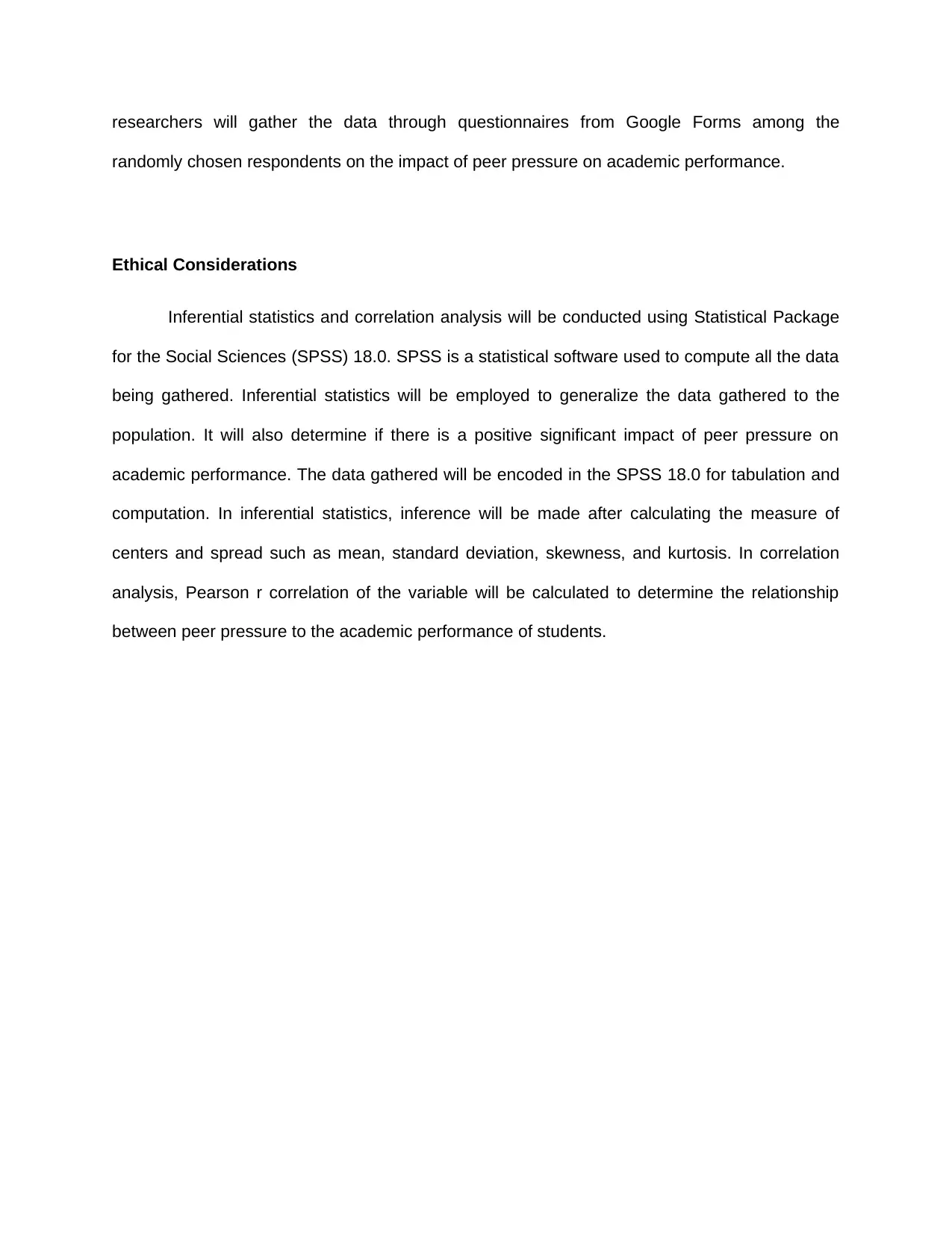
researchers will gather the data through questionnaires from Google Forms among the
randomly chosen respondents on the impact of peer pressure on academic performance.
Ethical Considerations
Inferential statistics and correlation analysis will be conducted using Statistical Package
for the Social Sciences (SPSS) 18.0. SPSS is a statistical software used to compute all the data
being gathered. Inferential statistics will be employed to generalize the data gathered to the
population. It will also determine if there is a positive significant impact of peer pressure on
academic performance. The data gathered will be encoded in the SPSS 18.0 for tabulation and
computation. In inferential statistics, inference will be made after calculating the measure of
centers and spread such as mean, standard deviation, skewness, and kurtosis. In correlation
analysis, Pearson r correlation of the variable will be calculated to determine the relationship
between peer pressure to the academic performance of students.
randomly chosen respondents on the impact of peer pressure on academic performance.
Ethical Considerations
Inferential statistics and correlation analysis will be conducted using Statistical Package
for the Social Sciences (SPSS) 18.0. SPSS is a statistical software used to compute all the data
being gathered. Inferential statistics will be employed to generalize the data gathered to the
population. It will also determine if there is a positive significant impact of peer pressure on
academic performance. The data gathered will be encoded in the SPSS 18.0 for tabulation and
computation. In inferential statistics, inference will be made after calculating the measure of
centers and spread such as mean, standard deviation, skewness, and kurtosis. In correlation
analysis, Pearson r correlation of the variable will be calculated to determine the relationship
between peer pressure to the academic performance of students.
⊘ This is a preview!⊘
Do you want full access?
Subscribe today to unlock all pages.

Trusted by 1+ million students worldwide
1 out of 6
Your All-in-One AI-Powered Toolkit for Academic Success.
+13062052269
info@desklib.com
Available 24*7 on WhatsApp / Email
![[object Object]](/_next/static/media/star-bottom.7253800d.svg)
Unlock your academic potential
Copyright © 2020–2025 A2Z Services. All Rights Reserved. Developed and managed by ZUCOL.